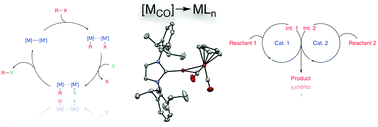Diverse bimetallic mechanisms emerging from transition metal Lewis acid/base pairs: development of co-catalysis with metal carbenes and metal carbonyl anions
Abstract
The rational development of catalytic reactions involving cooperative behavior between two catalytic reactive sites represents a frontier area of research from which novel reactivity and selectivity patterns emerge. Within this context, this Feature highlights the development of a cooperative system involving transition metal Lewis acid/base pairs. Bimetallic systems consisting of copper carbene Lewis acids and metal carbonyl anion Lewis bases, (NHC)Cu–[MCO], are easily synthesized from readily available organometallic building blocks (NHC = N-heterocyclic carbene; [MCO]− = metal carbonyl anion, e.g. [FeCp(CO)2]−, [Mn(CO)5]−, etc.). Stoichiometric reactivity studies indicate that the dative Cu←M bonds in these systems are labile towards heterolysis under mild conditions, thus providing in situ access both to polar metal–metal bonds and to “frustrated” transition metal Lewis acid/base pairs as dictated by reaction conditions. Catalytic transformations ranging from C–C and C–B coupling reactions to hydrogenation and other reductions have been developed from both manifolds: bimetallic catalysis involving (a) binuclear intermediates engaging in cooperative bond activation and formation, and (b) orthogonal mononuclear intermediates that operate in either tandem or co-dependent manners. Preliminary indications point to the future emergence of novel reactivity and selectivity patterns as these new motifs undergo continued development, and additionally demonstrate that the relative matching of two reactive sites provides a method for controlling catalytic behavior. Collectively, these results highlight the fundamental importance of exploring unconventional catalytic paradigms.



 Please wait while we load your content...
Please wait while we load your content...